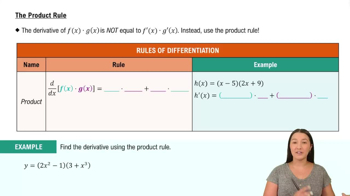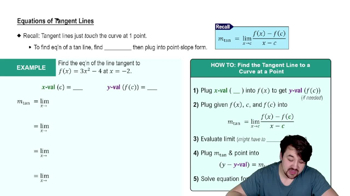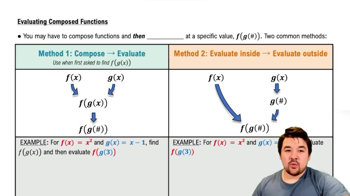Find all points (x, y) on the graph of y = x/(x − 2) with tangent lines perpendicular to the line y = 2x + 3.
Table of contents
- 0. Functions7h 54m
- Introduction to Functions16m
- Piecewise Functions10m
- Properties of Functions9m
- Common Functions1h 8m
- Transformations5m
- Combining Functions27m
- Exponent rules32m
- Exponential Functions28m
- Logarithmic Functions24m
- Properties of Logarithms36m
- Exponential & Logarithmic Equations35m
- Introduction to Trigonometric Functions38m
- Graphs of Trigonometric Functions44m
- Trigonometric Identities47m
- Inverse Trigonometric Functions48m
- 1. Limits and Continuity2h 2m
- 2. Intro to Derivatives1h 33m
- 3. Techniques of Differentiation3h 18m
- 4. Applications of Derivatives2h 38m
- 5. Graphical Applications of Derivatives6h 2m
- 6. Derivatives of Inverse, Exponential, & Logarithmic Functions2h 37m
- 7. Antiderivatives & Indefinite Integrals1h 26m
- 8. Definite Integrals4h 44m
- 9. Graphical Applications of Integrals2h 27m
- 10. Physics Applications of Integrals 3h 16m
- 11. Integrals of Inverse, Exponential, & Logarithmic Functions2h 31m
- 12. Techniques of Integration7h 41m
- 13. Intro to Differential Equations2h 55m
- 14. Sequences & Series5h 36m
- 15. Power Series2h 19m
- 16. Parametric Equations & Polar Coordinates7h 58m
3. Techniques of Differentiation
Product and Quotient Rules
Problem 51
Textbook Question
Assume that functions f and g are differentiable with f(1) = 2, f'(1) = −3, g(1) = 4, and g'(1) = −2. Find the equation of the line tangent to the graph of F(x) = f(x)g(x) at x = 1.
 Verified step by step guidance
Verified step by step guidance1
To find the equation of the tangent line to the graph of F(x) = f(x)g(x) at x = 1, we first need to determine the value of F(1). Since F(x) = f(x)g(x), we can substitute x = 1 to get F(1) = f(1)g(1). Given that f(1) = 2 and g(1) = 4, calculate F(1) = 2 * 4.
Next, we need to find the derivative of F(x) = f(x)g(x) using the product rule. The product rule states that if F(x) = f(x)g(x), then F'(x) = f'(x)g(x) + f(x)g'(x).
Substitute the given values into the derivative formula. We have f'(1) = -3, g(1) = 4, f(1) = 2, and g'(1) = -2. Therefore, F'(1) = f'(1)g(1) + f(1)g'(1) = (-3)(4) + (2)(-2).
Now that we have F(1) and F'(1), we can write the equation of the tangent line. The general form of the equation of a tangent line is y = F'(1)(x - 1) + F(1).
Substitute the values of F(1) and F'(1) into the tangent line equation to express the equation of the tangent line at x = 1.
 Verified video answer for a similar problem:
Verified video answer for a similar problem:This video solution was recommended by our tutors as helpful for the problem above
Video duration:
3mPlay a video:
Was this helpful?
Key Concepts
Here are the essential concepts you must grasp in order to answer the question correctly.
Product Rule
The product rule is a fundamental differentiation rule used when finding the derivative of a product of two functions. If F(x) = f(x)g(x), then the derivative F'(x) is given by f'(x)g(x) + f(x)g'(x). This rule is essential for determining the slope of the tangent line to the graph of F(x) at a specific point.
Recommended video:

The Product Rule
Tangent Line Equation
The equation of a tangent line to a curve at a given point is derived using the point-slope form: y - y₁ = m(x - x₁), where m is the slope of the tangent line and (x₁, y₁) is the point of tangency. For F(x) = f(x)g(x), the slope m is F'(1), and the point is (1, F(1)).
Recommended video:

Equations of Tangent Lines
Function Evaluation
Function evaluation involves substituting a specific value into a function to find its output. For F(x) = f(x)g(x), evaluating F(1) requires calculating f(1)g(1). This step is crucial for determining the y-coordinate of the point of tangency, which is needed for the tangent line equation.
Recommended video:

Evaluating Composed Functions
Related Videos
Related Practice
Textbook Question


